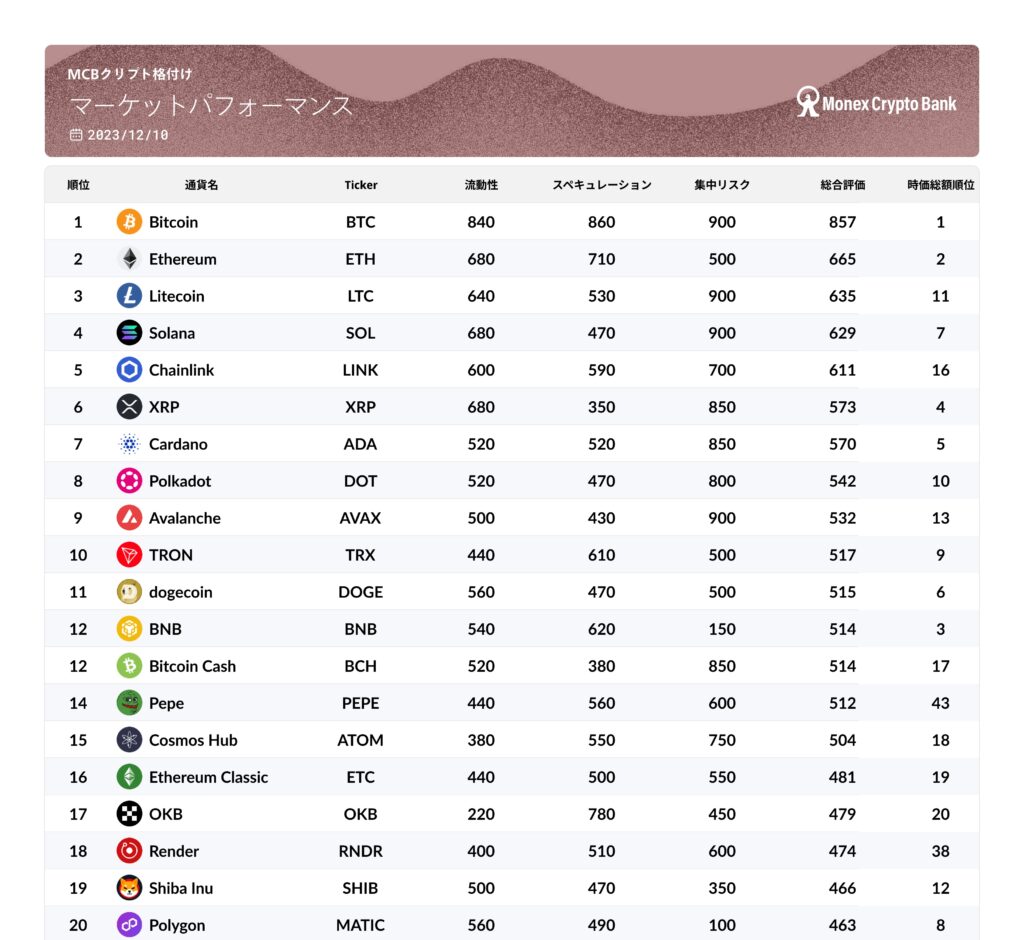
Manec Script Bank announced its own crypto asset rating evaluation model “MCB Crypto Rating” in July 2023, and has evaluated 30 types of crypto assets relative to each other based on 7 items. After its release, it was covered in the media and attracted a lot of attention among people involved in crypto assets and finance.
From there, we conducted interviews with various experts regarding the initial MCB crypto ratings, and based on the feedback we received from various sources, we conducted repeated trial and error efforts to devise a better rating evaluation model.
This time, we will announce the details of the MCB Crypto Rating, which has been significantly updated based on the discussions there. Below, I would like to explain in detail the contents of the update and the rating results for the new model, along with our future rating policy.
Contents of this update
1. Division of ratings according to data type
The previous rating comprehensively evaluated indicators based on market data, such as liquidity and catastrophe risk, and indicators based on non-market data, such as scalability, diversification, and hacking risk. However, indicators based on market data are easily influenced by overall market movements and do not represent the content of a crypto asset project, so we believe that they should be evaluated separately from project-specific characteristics such as commitment and governance. Ta.
Therefore, this time’s rating is divided into two main sections, depending on the type of data: the “Market Performance Section”, which evaluates indicators based on market data of crypto assets, and the “Project Assessment Section”, which evaluates indicators related to the operating entity of a crypto asset project. We decided to divide it into sections and calculate the overall evaluation for each section. This time, we will present the details of the former.
Regarding the market performance section, details will be described in the following sections, but typical indicators include trading volume, market capitalization, rate of change, and share by top addresses. A major feature is that approximately 50 stocks are included in the evaluation, an increase from the previous 30 stocks. The evaluation targets not only domestic listed stocks but also major overseas stocks, aiming to be able to check the market status of even more stocks. This is a change to further strengthen the original purpose of ratings: “By narrowing down the factors and grading, it is possible to compare and evaluate currencies with different characteristics using a certain standard.” be.
The project assessment section, which is currently under development, aims to create indicators to evaluate project governance, team commitment, token economics, etc., and to make it possible to compare the current position of projects. In this section, we will narrow down the target to around 15 stocks. Although the number of stocks is limited, we do thorough research on each individual stock and aim to provide more detailed and valuable information than anywhere else. This is a measure to further improve the other significance of ratings, which is that they are able to communicate important points to investors in an easy-to-understand format.
In this way, we plan to comprehensively rate crypto assets in two sections with clearly divided roles, and provide high-quality information that is easier to understand and more convenient for users.
2. Change evaluation to absolute evaluation
In the previous rating, we showed the position of crypto assets using relative evaluation. While this evaluation method is robust against fluctuations in the overall market, it has the drawback that it is difficult to grasp the growth of individual stocks. Specifically, there was a problem in that the changes in ratings over time had little meaning, and the meaning of scores varied greatly from time to time.
In response to this issue, we have changed the evaluation method from relative evaluation to absolute evaluation for each stock. This prevents the rating results from being significantly influenced by other stocks, and when looking at historical rating results, the numerical changes themselves become meaningful. For example, if a stock’s score increases over the course of a year, relative evaluation makes it unclear whether that stock has improved or other stocks have deteriorated, but absolute evaluation simply indicates that This indicates that the stock is in a positive state that is associated with an increase in score. This change was made to correctly represent the current status of each individual stock.
Additionally, the scoring method was changed from a 10-point scale to a 1000-point scale so that fluctuations in evaluations for each item would be more clearly reflected in the scores.
3.Renewal of evaluation items
This time, in dividing the evaluation axes into two broad categories, we have also revised the evaluation items. As mentioned above, the project assessment section is currently under development, so here we will explain the evaluation items of the market performance section. The evaluation will be broadly divided into the following three categories.
Liquidity (40%)
Liquidity is the most important information that can be obtained from market data, and was used as the main evaluation category in the previous rating. In this market performance section, we will continue to evaluate, with particular emphasis on risk management and screening. Specific examples of indicators that make up this category include trading volume, market capitalization, and trading volume as a percentage of market capitalization.
Speculation risk (40%)
In the previous rating, we focused solely on the risk of price decline, such as the maximum rate of change from the maximum price, using our own evaluation department called catastrophe risk. The new rating has been renamed “speculation risk,” and includes not only the risk of price decline, but also price increases such as return size, volatility, and Sharpe ratio, to comprehensively judge the speculative nature of each stock. do. In addition to sounding the alarm on stocks with excessively high speculative properties, they can also be used as a positive indicator for determining the expected value of price increases.
Concentration risk (20%)
This time, we have further strengthened concentration risk, which was the highlight of MCB Crypto Rating’s unique index. In addition to the occupancy rate by top addresses, which has been used as an indicator until now, we have adopted a new indicator to measure the degree of dispersion called the Gini coefficient. In the first place, the concentration of tokens in a few addresses impairs the decentralization that characterizes blockchain. If there is a significant oligopoly or monopoly by a certain address, large holders may have a significant impact on the token price in the event of some kind of market turbulence. Therefore, evaluating concentration risk from multiple angles is extremely important when evaluating crypto assets. With this update, the ability to measure the degree of concentration has improved dramatically, and the significance of the ratings has become even more important.
4. Increased update frequency
We have decided to increase the frequency of updates regarding the market performance section. Specifically, what was originally scheduled to be updated once every six months to once a year will now be updated once every month. In the rapidly changing world of crypto assets, there is great value in always providing the latest information. We decided to make this change because we believe that increasing the frequency is essential from the perspective of improving user convenience.
The initial market performance section evaluation reference date will be December 10th, and thereafter the evaluation reference date will be the 10th of every month. Even if the 10th is a holiday or holiday, the evaluation will be conducted on the 10th and the results will be announced on the next business day. Additionally, we plan to carry out major updates once a year, including reviewing the evaluation methods and evaluation items mentioned above. Regarding the market performance section, this review is scheduled to be carried out in conjunction with the evaluation update on January 10th of each year.
The project assessment section will continue to be updated approximately once every six months to a year. Evaluation methods and evaluation items will be reviewed once a year. The timing of the review will be announced later.
This rating result
Now, based on the above, I would like to announce some of the latest ratings in the market performance section.

 *Market capitalization ranking is the ranking within the target stock.
*Market capitalization ranking is the ranking within the target stock.The newly added stocks in this update are as follows.
“LINK, PEPE, OKB, RNDR, MKR, OP, UNI, LDO, AAVE, TON, FTM, INJ, BAT, MANA, ZIL, GRT, CRO, QNT, COMP, ALGO, SAND, XDC, CHZ, DYDX, HT , AXS”
In addition, the following stocks were previously eligible for rating but have been removed from rating this time.
“XMR, XLM, HBAR, XTZ, THETA, ICP, FLOW, XEC”
Although we do not individually disclose the reasons why a company is excluded from rating, the main reason is that we have determined that it is no longer possible to stably obtain the information necessary for rating evaluation.
Due to changes in the evaluation method, there were significant changes in the rankings compared to last time.
BTC and ETH still occupied the top two spots by far, but LTC, which was 8th last time, and SOL, which was 5th, rose to 3rd and 4th place, respectively. LINK, an Oracle project that was newly included in the rating, is ranked 5th. The reason for this result is that these three stocks are highly evaluated in terms of concentration risk in addition to their high liquidity.
Also, overall, the scores tended to decrease compared to the previous time. This is because the change to absolute evaluation has made the scoring standards more severe. Even under the new standards, the lineup of top stocks (those in the top 20 or so) has not changed much and gives the impression of being solid. On the other hand, when the criteria for investment grade was 600 points or more in this model and 6 points or more in the previous model, 16 stocks were eligible last time, but this time the number has decreased to only 5 stocks. There is.
The market performance section can be used as an indicator of the stability and profitability of each stock in the market. When making investment decisions, it is possible to easily compare different stocks by using full ratings that comprehensively evaluate carefully selected items. In addition, by using an index specialized in market data, the evaluation strongly reflects the situation of token holders and users, rather than the characteristics of the issuer such as supply and demand, return size, and token holder bias. This will help you get a bird’s-eye view of the market sentiment. For individual investors in particular, this will serve as a reassuring indicator when narrowing down stocks to invest in. In the future, we would like to closely monitor changes in scores and conduct a detailed analysis of the causes. We also plan to add evaluation targets from time to time while listening to investor feedback, so if you have any stocks you would like to add, please leave a comment on our X account post.
Additionally, the project assessment section currently under development evaluates the nature and characteristics of the project itself, which is unaffected by market prices. For example, by comparing the evaluations of already mature projects and similar projects, we believe that this will lead to the possibility of giving preliminary evaluations to new projects that are considering IEO or INO in the future. In the future, through collaboration with issuers, we would like to proceed with the development of indicators that are beneficial to both issuers and investors. If you are a project that is considering issuing tokens in the future or would like to handle tokens in Japan, please contact us.
In addition, you can view all rating tables by registering for the web3 newsletter provided by Manec Script Bank. Click here to register.
|Editing: CoinDesk JAPAN Editorial Department
|Image:manec script bank
The post Regarding the major update of “MCB Crypto Rating”: MCB Crypto Rating Evaluation Featured News | CoinDesk JAPAN appeared first on Our Bitcoin News.

 1 year ago
156
1 year ago
156














 English (US) ·
English (US) ·